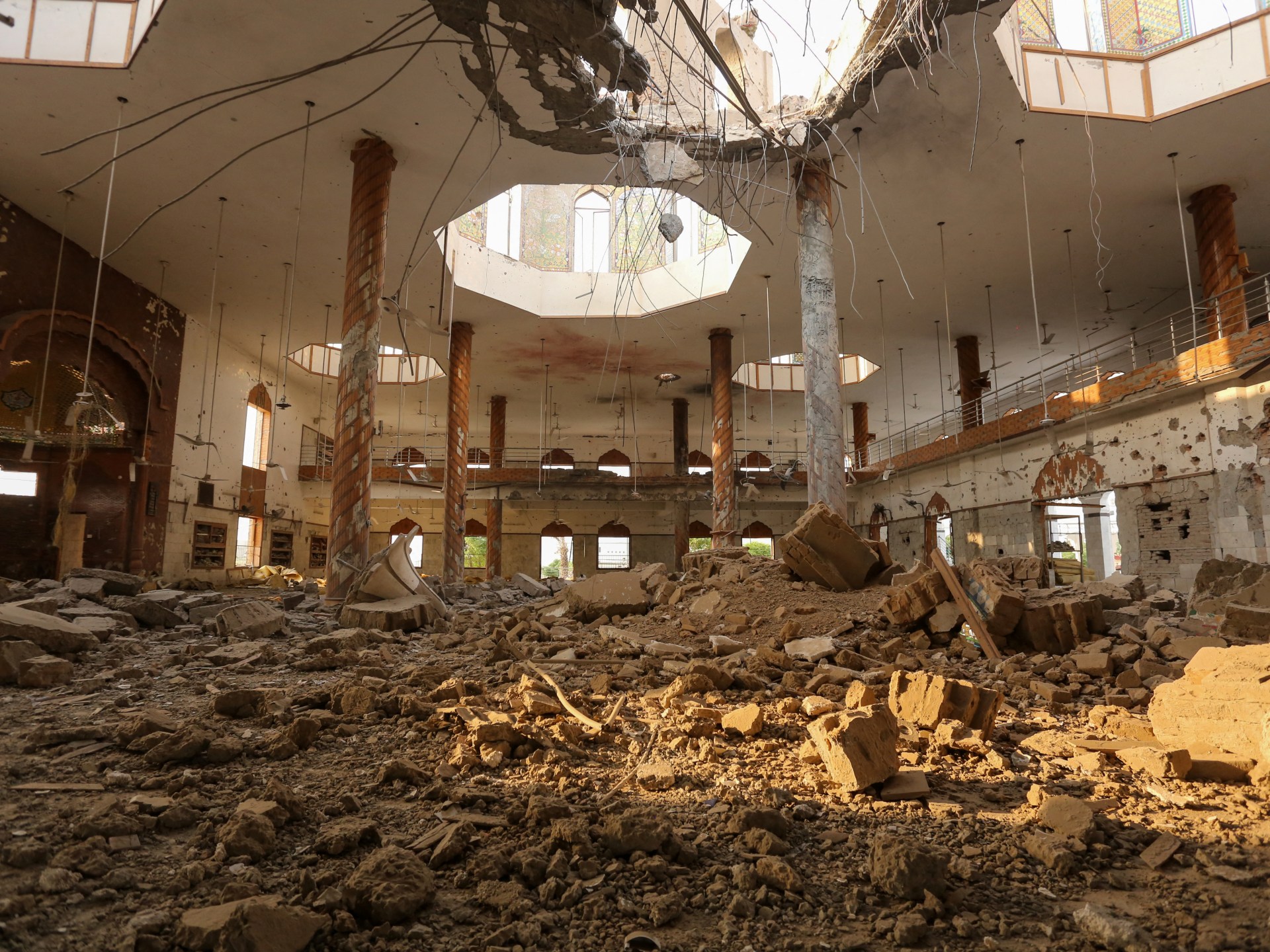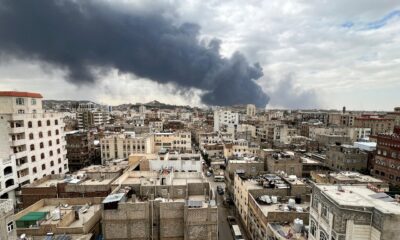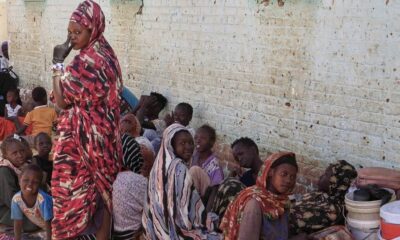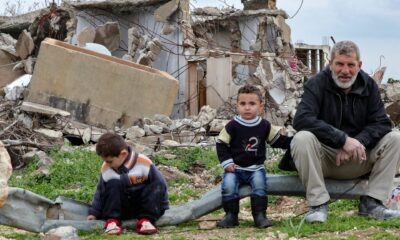Conflict Zones
Information war: Are India or Pakistan telling the truth about attacks? | India-Pakistan Tensions News

Competing press briefings. Divergent claims. And conflicting narratives.
As Indian attacks on Pakistan and Pakistan-administered Kashmir early in the morning on May 7 pulled the nuclear-armed neighbours to the brink of a potential military conflict, a parallel war quickly broke out — over information.
Within hours of the Indian strikes, authorities on both sides put out claims and counterclaims that have been amplified on social media as each country tries to control the narrative in its favour.
Five Indian jets were downed, Pakistan said, for instance. India has yet to respond to the claim: Officials who requested anonymity confirmed that three jets had crashed in Indian-administered Kashmir, but did not confirm whether they were Indian or Pakistani planes.
Here is a look at what both India and Pakistan have claimed so far — and how they have a history of competing narratives that often allow them to each assert wins over the other to their respective domestic audiences, while making independent verification of the truth harder.
What was targeted?
India said its forces hit “terrorist infrastructure” at nine sites in response to last month’s deadly shooting attack in Pahalgam in India-administered Kashmir. India blamed Pakistan for the Pahalgam attack, in which 26 civilians were killed. Islamabad denied the charges and asked India to provide evidence to back up its claims.
Pakistan said Indian forces on Wednesday hit six cities in Pakistan and Pakistan-administered Kashmir and a health centre.
Pakistan said civilians were killed, including a three-year-old girl.
But Indian Defence Minister Rajnath Singh said his forces did not harm civilians. In a news briefing, Indian air force Wing Commander Vyomika Singh said the strikes led to “no collateral damage” and had been conducted through “precision capability”.

Did Indian forces hoist a white flag at LoC?
The Pakistani government on its official X account said Indian soldiers raised a white flag, a common symbol of surrender, at a military post along the Line of Control, the de facto border that divides Indian-administered and Pakistan-administered Kashmir.
Pakistani Minister for Information and Broadcasting Attaullah Tarar echoed the claim on his X account, posting: “First they fled from the investigation, now they fled from the field.”
Indian authorities have yet to formally address the claim, but as India and Pakistan are not officially at war, it is unclear why New Delhi might feel the need to surrender.
Were warplanes downed? How many? And who did they belong to?
Pakistan military spokesperson Ahmed Sharif Chaudhry said five Indian jets had been downed, all within Indian territory, with planes from neither side crossing into the other’s airspace.
According to Indian security sources who spoke to Al Jazeera, three fighter jets have been downed inside Indian-controlled territory. However, it was not clear whether they were Pakistani or Indian warplanes.
While there has been no comment from the federal government, the Indian embassy in China dismissed claims of Indian jets being brought down in Chinese state media outlet Global Times as “disinformation”.

History of conflicting claims
Previous escalations between India and Pakistan have also generated conflicting claims and accusations, often leaving observers to ponder which account — if either — reflects the truth.
In February 2019, Indian forces said they had hit a large number of “JeM [Jaish-e-Muhammad] terrorists, trainers, senior commanders and groups of jihadis” in Balakot in Pakistan-administered Kashmir, weeks after a suicide attack killed 40 members of the security forces in India-administered Kashmir’s Pulwama.
Formed in 2000, JeM has carried out numerous attacks on Indian forces in India-administered Kashmir. Both India and Pakistan have designated the armed group as a “terrorist organisation”, but its leader Masood Azhar has been allowed to operate in Pakistan. His current whereabouts are unknown.
Pakistan, which denied having a role in the Pulwama attack, said the Indian air attacks in 2019 hit an uninhabited forest.
Similarly, in 2016, Pakistan rejected India’s claims of “surgical strikes” against “terrorist units” on its territory after an attack on an Indian army base that killed 18 soldiers in Uri in India-administered Kashmir.
The Pakistani military called the claims an “illusion” and said India had engaged in nothing more than “cross-border fire, … which is an existential phenomenon”.
Conflict Zones
‘Nowhere to go’: Kashmir violence escalates amid India-Pakistan crossfire | Conflict News

Indian and Pakistani soldiers exchanged gunfire overnight in Kashmir, a day after the worst violence between the nuclear-armed rivals in two decades.
Pakistani Prime Minister Shehbaz Sharif pledged to retaliate after India launched deadly missile attacks on Wednesday morning, with days of repeated gunfire along their border escalating into artillery shelling.
“We will avenge each drop of the blood of these martyrs,” Sharif said, in an address to the nation.
India said it had destroyed nine “terrorist camps” in Pakistan in “focused, measured and non-escalatory” strikes, two weeks after New Delhi blamed Islamabad for backing an attack on tourists in the Indian-administered side of disputed Kashmir – a charge Pakistan denies.
At least 44 deaths have been reported from both sides of the border following Wednesday’s violence, including children. Islamabad said 31 civilians were killed by Indian attacks and firing along the border. New Delhi said 13 civilians and a soldier had been killed by Pakistani fire.
The largest Indian attack was on an Islamic seminary near the Punjabi city of Bahawalpur, killing 13 people, according to the Pakistan military.
Madasar Choudhary, 29, described to the AFP news agency how his sister saw two children killed in Poonch, on the Indian side of the frontier, on Wednesday.
“She saw two children running out of her neighbour’s house and screamed for them to get back inside,” Choudhary said, narrating her account because she was too shocked to speak. “But shrapnel got to the children – and they eventually died.”
Muhammad Riaz said he and his family had been made homeless after Indian attacks hit Muzaffarabad, the main city of Pakistan-administered Kashmir.
“We have no place to live,” he told AFP. There is no space at our relatives’ house. We are very upset; we have nowhere to go.”
On Wednesday night, Pakistan military spokesman Ahmed Sharif Chaudhry reported firing across the Line of Control – the de facto border in Kashmir – and said the army had been authorised to “respond in self-defence” at a “time, place and manner of its choosing”.
India’s army on Thursday morning reported firing “small arms and artillery guns” in multiple sites overnight, adding that its soldiers had “responded proportionately”, without giving further details.
India and Pakistan have fought multiple times since the violent end of British rule in 1947, when colonial officers drew straight-line borders on maps to partition the nations, dividing communities.
Muslim-majority Kashmir – claimed by both India and Pakistan – has been a repeated flashpoint.
Conflict Zones
‘Don’t want war’: Kashmiri towns caught in deadly India-Pakistan crossfire | India-Pakistan Tensions

Srinagar, Indian-administered Kashmir – As the camera panned around a home blown up by the mortar fire in Poonch, an embattled hill city perched on the disputed border between India and Pakistan, a disembodied female voice cried out.
“This is a calamity.”
The video, shared with Al Jazeera by locals in Poonch, revealed a collapsed staircase, large craters in the walls, and a courtyard cluttered with rubble and clothes, and painted in blood.
“Everything I built is in ruins,” the voice exclaimed, loaded with anguish.
At least 11 people have been killed in Poonch district from Pakistani firing into Indian-administered Kashmir since early May 7, in retaliation for Indian missile strikes that hit multiple sites across Pakistan’s Punjab province and Pakistan-administered Kashmir.
The Indian strikes – themselves a response to a deadly attack on tourists in Indian-administered Kashmir’s Pahalgam on April 22 – mark the most extensive attack on Pakistani soil since their 1971 war that ended with the eastern wing of Pakistan lopped off, resulting in the creation of Bangladesh.
Yet, as the nuclear-armed neighbours stand on the edge of a potential military conflict, many Kashmiris say they are facing the brunt of their tensions. Pakistan’s bombardment of Indian-administered Kashmir on Wednesday night was, according to locals and experts, the most intense shelling that villages and towns in the region have seen in more than 40 years.
“This was a night of terror,” Rameez Choudhary, a resident of Poonch, told Al Jazeera.
The dead, officials told Al Jazeera, included two siblings who were crushed to death after an exploding shell dropped on their house; two local store-owners who were hit by the raining munitions; a seven-year-old child; a teenage boy; a 35-year-old homemaker; and four other men.
The worst-hit villages in Poonch district were Shahpur, Mankote and Krishna Ghati, while shelling also intensified in Rajouri district’s Laam, Manjakote, and Gambhir Brahmana areas as residents fled to safety.

‘This war has been forced upon us’
The border skirmishes have followed the deadly attack at the tourist resort town of Pahalgam in Indian-administered Kashmir two weeks ago, in which 26 people, mostly Indian visitors holidaying in the disputed region, were killed.
During the wee hours on Wednesday, Indian military warplanes arced across the skyline and fired missiles and other munitions into neighbouring Pakistan. Indian authorities said they targeted at least nine locations inside Pakistan.
India charges Pakistan with supporting the armed group that attacked Indian tourists. Pakistan, however, has denied the accusation. India claims its missiles hit “terror base camps”, but Pakistan says the strikes killed 31 people, all of whom were “innocent civilians”.
The scale and spread of the current military tensions – India struck four cities separated by hundreds of kilometres in Pakistan’s Punjab province, in addition to sites in Pakistan-administered Kashmir – make them even graver, in some ways, than the last war between the neighbours in 1999, say some experts.
Back then, servicemen from the Pakistani army had disguised themselves as rebel fighters and taken up positions in the snow-covered, craggy mountains of Kargil, territory under de facto Indian control, leading to a conflict. Hundreds of soldiers died on each side, but the battles were – unlike this week – contained to Kargil.
“This war has been forced upon us. The [Pahalgam] attack was aimed at provoking a situation in which we have no option but to strike back,” said Tara Kartha, director at the Centre for Land Warfare Studies (CLAWS), a New Delhi-based think tank, and a former official at India’s National Security Council Secretariat.
To be sure, the countries came close to war in 2019 in the aftermath of the deadly attack in Pulwama town in South Kashmir when a suicide bomber blew up an Indian paramilitary motorcade, killing 40 Indian servicemen. Indian fighter jets fired missiles that struck Balakot in Pakistan-administered Kashmir.
But according to Kartha, the current crisis is different.
“Both sides carefully managed 2019. Everything was kept confined to a certain limit. But this time, it has been brutal,” she said, while arguing that “India has been very mature”. Pakistan’s military and civilian government have, however, accused India of fanning the flames of war and escalating tensions.
Caught on the front lines of their confrontation are Kashmiris. On Wednesday, three different regions in Indian-administered Kashmir were struck by Pakistani shelling.
“Initially, we thought it was thunder. The skies rumbled at 1am,” Altaf Amin, a 22-year-old resident of Chandak village in Poonch, told Al Jazeera.

‘We don’t want war’
Poonch is just 10km (six miles) from the Line of Control (LoC), the contested border that separates the Indian- and Pakistan-controlled territories in Kashmir. “The shelling has continued on and off since yesterday. But now, it has stopped,” said Amin.
Social media was quickly flooded with videos showing the severity of the human toll in the border shelling. A clip whose veracity was authenticated by Al Jazeera shows the bloodied body of a teenage boy being carried into a van in Poonch. One of his arms had been blown apart. The different segments in the same clip showed a lifeless body of a child, his head ripped open by a shell.
Amid it all, one refrain emerged loud and clear: “We don’t want war,” said Amin.
Yet, there is also anger on the ground against local authorities.
“People in Poonch are angry because there was no attempt to get them evacuated,” Zafar Choudhary, a political analyst and veteran journalist based in the Jammu region, told Al Jazeera.
Choudhary said that the strikes from the Pakistani side should have been anticipated by the Indian government, and people should have been evacuated to avoid the casualties.
“But none of that happened, which has left people infuriated. There’s a feeling that whenever the trouble between the two warring nations has erupted in the past, it is the people of these hill regions who have borne its brunt,” he said.

Silent guns roar again
The LoC traverses a 740km (459-mile) circuitous route through the mountains, forested ridges, alpine lakes and rivers of the disputed Kashmir region. The line came into being in 1949 after the newly independent India and Pakistan fought their first war over Kashmir, which was then one of the 565 princely states ruled indirectly by colonial Britain.
As both countries rallied their militaries to claim the picturesque region, they eventually settled for a stalemate that forced them to recognise each other’s spheres of influence. The ceasefire line was given recognition by the United Nations, which tried to mediate a referendum in Kashmir so that its people could choose their future.
The vote never happened, and both nations continued to spar occasionally along the disputed border. After the 1971 war that Pakistan lost to India, the ceasefire line was renamed as the LoC. In 2003, after a more than decade-long uprising in Kashmir began to subside, and both countries initiated a peace process to ease hostilities, India took advantage of the truce period to fence off its side of LoC with spools of concertina wire.
The two countries agreed to a ceasefire deal that they renewed in 2021.
Four years later, that agreement effectively lies in tatters.

‘This shelling is unprecedented’
Amin, the villager in Chandak, said that although artillery duels have been common in the border area, the guns had fallen relatively silent since both countries reaffirmed the 2003 ceasefire deal four years ago. “We are familiar with cross-border shelling. But this shelling is unprecedented.”
Another resident from Poonch, which is where most damage has taken place, said that people there have now started following a series of war protocols announced by the government, including building makeshift bunkers.
Residents said many schools in Chandak have been converted into relief centres, with provisions of food and other essentials.
Nearly 260km (162 miles) away from Poonch district, the residents of Salamabad Uri, a border village in Baramulla district, northern Kashmir, have fled their homes, too.
“Last night, the shelling was so intense that two houses were burned down and many people were wounded in the fire from across the border,” Mushtaq Ahmad, 40, a cab driver from the village, said. Ahmad has now moved to the town of Uri.
Salamabad, which is ringed by a pine-covered massif that juts out into Pakistan, has been devastated by near-continuous shelling. Powerful blasts have ripped away corrugated iron roofs from homes, exposing them to harsh sunlight. The inferno caused by the shelling has blazed through neighbourhoods, leaving behind smouldering debris.
“We fear the worst,” said Ahmad, adding that his two daughters, aged 9 and 11, are frightened.
“They are asking why it happened? Would we be killed?” Ahmad says, adding that the cross-border shelling started at 2am on Wednesday, and left two minors – a 13-year-old girl and a four-year-old boy – wounded.
Ghulam Muhammad Chopan, an 80-year-old resident, said that he felt too old to leave his home, but that there was no other option.
“At this age, I had to leave my house. At night, the firing was so intense that by dawn, the village was empty. Everyone fled,” he said.
In Wuyan town in Pampore, a highland area surrounded by a maze of escarpments where the prized Kashmiri saffron grows, townspeople said they were jolted out of their sleep at 1:30am after they heard a loud booming sound.
“A fireball exploded with a flash,” said Gulzar Ahmad, a resident. “I could see two aircraft. One of them returned promptly. But the other one that exploded, its wreckage had fallen into a school playground. Later, it started emitting acrid smoke that drew a large crowd.”
Pakistan claims it shot down five Indian fighter jets on Wednesday morning. While multiple independent reports suggest that at least three planes were indeed shot down, India is yet to confirm any such losses.
As uncertainty lingers over the escalation of tensions between India and Pakistan, locals in Indian-administered Kashmir are fearful and uncertain about their future.
Residents have started hoarding food, fuel and other essential items, anxious and desperate to survive violence they never invited.
“War should never be rejoiced. When the shells hit, they don’t ask your identity,” said Farooq Ahmad, a resident of Kamalkote village in Uri. “Those calling for the war do not know how it feels when a shell lands on your kids when they are asleep at night.”
Conflict Zones
Russia-Ukraine war: List of key events, day 1,169 | Russia-Ukraine war News

Here is where things stand on Thursday, May 8:
Fighting
A three-day ceasefire declared by Russia to commemorate the 80th anniversary of the defeat of Nazi Germany came into effect at midnight, Moscow time (21:00 GMT, Wednesday). Ukraine has not committed to abide by the ceasefire, proposing a 30-day cessation in fighting instead.
Russian aircraft launched guided bombs on the Sumy region of northern Ukraine in the early hours of Thursday morning despite the ceasefire, Ukraine’s air force said in a post on Telegram. There were no immediate reports of casualties or damage.
Apart from the Ukrainian air force’s statement about Russia launching guided bombs, there were no other reports of attacks on Ukrainian cities early on Thursday.
Russian forces shot down 12 Ukrainian drones approaching Moscow, the capital’s mayor, Sergei Sobyanin, said on Wednesday. Russia’s aviation watchdog said two airports – the Zhukovsky airport in the Moscow region and the main airport in Kaluga – were temporarily closed.
Politics and diplomacy
Russia’s Ministry of Foreign Affairs spokeswoman Maria Zakharova said Moscow had never opposed a ceasefire in Ukraine, Russian state-run news agencies reported on Wednesday, after United States envoy Keith Kellogg said Russian President Vladimir Putin may be obstructing a comprehensive peace deal.
Ukrainian President Volodymyr Zelenskyy said in his nightly address on Wednesday that he stood by an offer to observe a 30-day ceasefire. “We are not withdrawing this proposal, which could give diplomacy a chance,” Zelenskyy said.
US Vice President JD Vance said during an appearance at the Munich Security Conference that Russia was “asking for too much” in its initial offer of a peace deal.
Economy
In an interview with the Reuters news agency, Ukraine’s Central Bank governor, Andriy Pyshnyy, said Kyiv is considering a shift away from the US dollar. Potential accession to the European Union and “the probability of global-trade fragmentation”, among other reasons, are forcing the central bank to review whether the euro should be the reference currency for Ukraine’s hryvnia, Pyshnyy was quoted as saying.
-

 Lifestyle2 days ago
Lifestyle2 days agoOne Tech Tip: Skype shut down for good, but users still have these alternatives
-

 Sports2 days ago
Sports2 days agoFan who fell onto field at PNC Park during Pirates game takes first steps
-

 Europe2 days ago
Europe2 days agoIndia just agreed a massive trade deal – with the UK
-

 Middle East2 days ago
Middle East2 days agoIsrael has turned 70% of Gaza into no-go zones, in maps | Israel-Palestine conflict News
-

 Middle East2 days ago
Middle East2 days agoIsrael hits Yemen’s Houthi-controlled Sanaa airport in tit-for-tat attack | Houthis News
-

 Africa2 days ago
Africa2 days agoNew wave of Sudanese refugees flee into neighbouring Chad
-

 Europe2 days ago
Europe2 days agoTesla sales plunge across Europe
-

 Middle East2 days ago
Middle East2 days agoSeeking funds to rebuild, Lebanon government works to regain donor trust | Israel attacks Lebanon News




